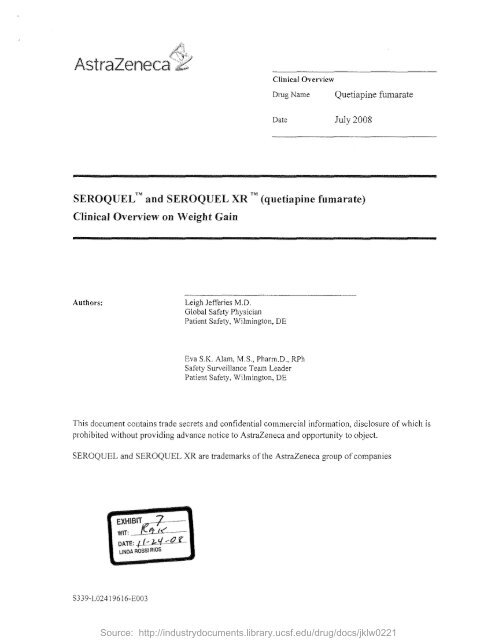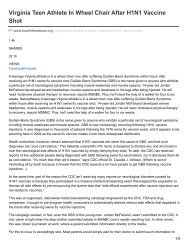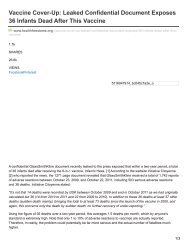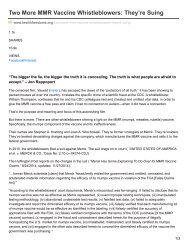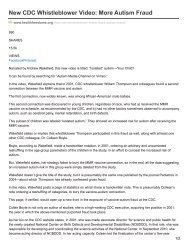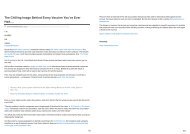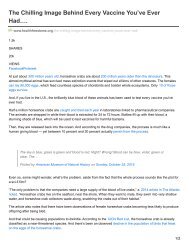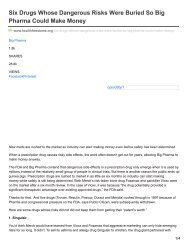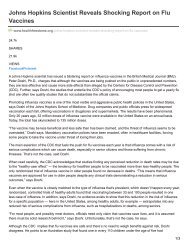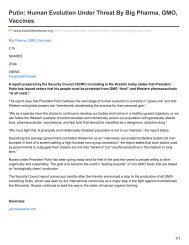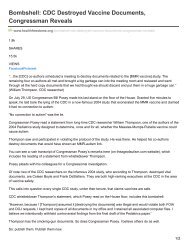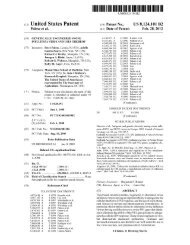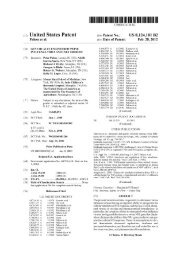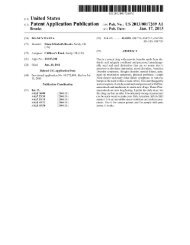jklw0221
Create successful ePaper yourself
Turn your PDF publications into a flip-book with our unique Google optimized e-Paper software.
• >'""•<br />
^, '•'% '•<br />
/"lOU C3*»viri IdTx^CSI iS«->"<br />
Clinical Overview<br />
Drug Name<br />
Quetiapine fumarate<br />
Date July 2008<br />
IIH H
TABLE OF CONTENTS<br />
PAGE<br />
TITLE PAGE , 1<br />
TABLE OF CONTENTS 2<br />
1. PRODUCT DEVELOPMENT RATIONALE 3<br />
1.1 Introduction 3<br />
1.1.1 SEROQUEL and SEROQUEL XR 3<br />
1.2 Proposed label change 4<br />
2. OVERVIEW OF BIOPHARMACEUTICS 4<br />
3. OVERVIEW OF CLINICAL PHARMACOLOGY 4<br />
4. OVERVIEW OF EFFICACY 4<br />
5. OVERVIEW OF SAFETY 4<br />
5.1 Data summary and discussion „ 4<br />
5.1.1 Acute placebo-controlled trials 5<br />
5.1.2 All Trials 5<br />
5.1.3 Overall summary of adult clinical trial data 5<br />
6. BENEFITS AND RISKS CONCLUSIONS 6<br />
7. REFERENCES 6<br />
LIST OF TABLES<br />
Table 1<br />
Undesirable effects 4<br />
Incidence and relative incidence for weight gain risk, adult<br />
subjects - all Placebo-controlled trials 5<br />
Table 2 Incidence weight gain, adult subjects - all trials 5<br />
2<br />
Source: http://industrydocuments.library.ucsf.edu/drug/docs/<strong>jklw0221</strong>
1, PRODUCT DEVELOPMENT RATIONALE<br />
1.1 Introduction<br />
The Core Data Sheets for SEROQUEL and SEROQUEL XR are to be amended following an<br />
internal safety evaluation and review meeting on 09 July 2008. The purpose of this document<br />
is to summarize the key information on which the decision to amend the CDS was based, to<br />
document the Core Data Sheet amendment and to support changes to local Prescribing<br />
Information.<br />
1.1.1 SEROQUEL and SEROQUEL XR<br />
SEROQUEL and SEROQUEL XR are atypical antipsychotic agents, presented as tablets<br />
containing quetiapine fumarate, which exhibits affinity for brain serotonin (5HT2) and<br />
dopamine Dl and D2 receptors. In addition, SEROQUEL/SEROQUEL XR also have high<br />
affinity at histaminergic and adrenergic al receptors, with a lower affinity at adrenergic a2<br />
receptors, but no appreciable affinity at cholinergic, muscarinic or benzodiazepine receptors.<br />
SEROQUEL was first approved for marketing in the United Kingdom (UK) on 31 July 1997<br />
and was first launched in the UK on 22 September 1997. By 31 March 2008, SEROQUEL<br />
has been approved in 89 countries for schizophrenia, 86 countries for bipolar mania, (with<br />
Mexico being the first country to approve bipolar mania on 29 May 2003), 26 countries for<br />
bipolar depression, (with Czech Republic being the first country to approve bipolar depression<br />
on 27 September 2006), and in one country for bipolar maintenance (USA being the first<br />
country to approve bipolar maintenance on 14 May 2008). SEROQUEL is presented as<br />
tablets delivering a dose of 25 mg, 50 mg, 100 mg, 3 50 mg, 200 mg, 300 mg, or 400 mg of<br />
quetiapine free-base. SEROQUEL is not approved for children or adolescents below 18 years<br />
of age.<br />
SEROQUEL XR was first approved for marketing in the United States (US) for acute<br />
schizophrenia on 18 May 2007 and for maintenance of schizophrenia on 15 November 2007.<br />
By 31 March 2008, SEROQUEL XR has been approved in 30 countries for schizophrenia<br />
(including 14 countries in the Mutual Recognition Procedure), 7 countries for bipolar mania<br />
(with Slovakia being the first country to approve bipolar mania on 28 June 2007), and in one<br />
country for bipolar depression (Mexico being the first country to approve bipolar depression<br />
in October 2007). SEROQUEL XR is presented as tablets delivering a dose of 50 mg, 200<br />
mg, 300 mg, or 400 rng of quetiapine free-base. SEROQUEL XR is not approved for children<br />
or adolescents below 18 years of age.<br />
It has been estimated that about 22.8 million patients worldwide have been exposed to<br />
SEROQUEL/SEROQUEL XR since launch through the end of February 2008. This estimate<br />
is based upon; (1) assumptions as to the number of prescriptions per patient, based upon 2007<br />
United States (US) market research; and (2) projections of prescriptions since launch based<br />
upon information available in the US (dispensed prescriptions from retail, long-term care and<br />
mail order) and 12 other countries (Australia, Belgium, Canada, Egypt,Germany, Italy, Japan,<br />
Source: http://industrydocuments.library.ucsf.edu/drug/docs/<strong>jklw0221</strong>
Netherlands, Saudi Arabia, Spain, and United Kingdom; written prescriptions from office<br />
based physicians) in which SEROQUEL/SEROQUEL XR is marketed.<br />
1.2 Proposed label change<br />
The event of weight gain is to be changed from common to very common in the table in<br />
Section 4.8 Undesirable effects of the SEROQUEL and SEROQUEL XR Core Data Sheets.<br />
In addition, footnote three will be updated as follows (new text: double underline):<br />
Undesirable effects<br />
Frequency System organ class Event<br />
Very common Investigations Weight Gain 3<br />
(>10%)<br />
"i • '- "•— •<br />
Baaed on >7%Jncrease in bodyj^ejght from baseline. Occurs predominantly during the early weeks of<br />
treatment in adults.<br />
2. OVERVIEW OF BIOPHARMACEUTICS<br />
This section is not relevant to this document.<br />
3. OVERVIEW OF CLINICAL PHARMACOLOGY<br />
This section is not relevant to this document.<br />
4. OVERVIEW OF EFFICACY<br />
This section is not relevant to this document.<br />
5. OVERVIEW OF SAFETY<br />
5.1 Data summary and discussion<br />
The frequency of weight gain previously categorized as uncommon was based on adverse<br />
event (AE) data from AstraZeneca clinical trials. Beginning in approximately 2001,<br />
according to AstraZeneca standard operating procedure (SOP 110-G), abnormal<br />
laboratory/vital signs values are not reported as AEs unless the abnormal value fulfils any<br />
criterion for a serious AE (SAE), the abnormal value results in the subject's discontinuing<br />
from the study (DAE) or the investigator insists that the abnormal value be reported as an AE.<br />
Symptoms associated with the abnormal laboratory value are reported as AEs. Thus, since<br />
this percentage includes AE reports both before and after the institution of this SOP, the<br />
percentage is difficult to interpret.<br />
4<br />
Source: http://industrydocuments.library.ucsf.edu/drug/docs/<strong>jklw0221</strong>
5.1.1 Acute placebo-controlled trials<br />
The data below are taken from the cumulative clinical trial database (vl 5 [through<br />
18 June 2008]) for quetiapine. In acute placebo-controlled trials of quetiapine in adult patients<br />
(>18 years of age) the incidence rate in patients with >7% weight gain was 9.6% in the<br />
quetiapine group and 3.8% in the placebo group. The relative risk estimate was 2.5 (95% CI:<br />
3.00, 2.10) (see Table 1).<br />
Table 1 Incidence and relative incidence for weight gain risk, adult subjects -<br />
all Placebo-controlled trials<br />
Risk<br />
QTP<br />
incidence<br />
rate<br />
N=7481<br />
Pla<br />
incidence<br />
rate<br />
N=3501<br />
Relative<br />
incidence<br />
compared<br />
to Pla<br />
Relative<br />
incidence<br />
95% CIs<br />
n {%) n (%) Ratio Lower Upper<br />
Weight gain (> 7% increase) 723 (9.6) 134(3.8) 2.5 2,1 3.0<br />
CI Confidence interval. Pla Placebo. QTP Quetiapine.<br />
Numbers in heading are patients with weight values at baseline and at least one value post baseline.<br />
Note: Patients with multiple adverse events are counted oniy once.<br />
Note: Percentages are calculated as (n/N)* 100.<br />
Note: Trial D1448C00005, D1444C00004, D1447C00126, DS447C00144, D1448C00012 and D1447C00127 are excluded due to their<br />
initial uncontrolled open label phase prior to the randomised phase. Only the acute phase is included for trial D1447C00001and<br />
D1447C00134.<br />
Program: Reg-DefProlactin May 08 MHRA\...\weigth_inc_pia_ctr.SAS. Programmer: F Stromberg. 2008-06-18 15:23. DB version: 15<br />
5.1.2 AH Trials<br />
In all adult quetiapine clinical trials, the incidence of patients who had an increase of >7% of<br />
their body weight from baseline at any time was 18.2% (see Table 2).<br />
Table 2<br />
Incidence weight gain, adult subjects - all trials<br />
QTP<br />
incidence<br />
rate<br />
Risk N=22382<br />
n (%)<br />
Weight gain (> 7% increase) 4070 (18.2)<br />
Number in heading are patients with weight values at baseline and at least one value post baseline.<br />
Note: Patients with multiple adverse events are counted only once.<br />
Note: Percentages are calculated as (n/N)*100.<br />
Program: Reg-Def\ProIactio May 08 MHRAV..\weigthJnc_ali.SAS. Programmer: F StrOmberg. 2008-06-26 9:14. DB version: 3 5<br />
5.1.3 Overall summary of adult clinical trial data<br />
In acute placebo-controlled trials of quetiapine in adult patients (>18 years of age), the<br />
incidence rate in patients with >7% weight gain was 9.6% in the quetiapine group and 3.8% in<br />
the placebo group. In all adult quetiapine clinical trials, the incidence of patients who had an<br />
5<br />
Source: http://industrydocuments.library.ucsf.edu/drug/docs/<strong>jklw0221</strong>
increase of >7% of their body weight from baseline at any time was 18.2%. Therefore, the<br />
incidence of weight gain is to be changed from common to very common in the SEROQUEL<br />
and SEROQUEL XR Core Data Sheet, which represents the frequency in patients >18 years<br />
of age. In addition, the frequency will be changed from representing AE reports to actual<br />
weight gain data.<br />
6. BENEFITS AND RISKS CONCLUSIONS<br />
The purpose of this application is to update the SEROQUEL and SEROQUEL XR Core Data<br />
Sheets and local Prescribing information with current findings in relation to weight gain in<br />
patients treated with quetiapine. AstraZeneca believes that these data do not alter the overall<br />
safety and tolerability profile of SEROQUEL and SEROQUEL XR and that the benefit/risk<br />
profile of SEROQUEL and SEROQUEL XR remains positive.<br />
7. REFERENCES<br />
Correll et a! 2006<br />
Correll CU, Carlson HE. Endocrine and metabolic adverse effects of psychotropic<br />
medications in children and adolescents. J. Am. Acad. Child. Adolesc. Psychiatry. 2006; 45<br />
(7):771-791.<br />
Reyes et al 2006<br />
Reyes M, Croonenberghs J, Augustyns I, Eerdekens M. Long-term use of risperidone in<br />
children with disruptive behavior disorders and sub average intelligence: efficacy, safety and<br />
tolerability. J. Child. Adolescent. PsychopharmacoL 2006; 16(3): 260-272.<br />
6<br />
Source: http://industrydocuments.library.ucsf.edu/drug/docs/<strong>jklw0221</strong>
According to his/her respective qualification the undersigned expert declares hereby to have<br />
performed the duties set out in the Article 12 and in accordance with Annex I Part I 1.4 of<br />
Directive 2001/83/EC, as amended<br />
CLINICAL:<br />
Name of the expert: Leigh Jefferies, MD<br />
Global Safety Physician<br />
Patient Safety<br />
Signature:<br />
,, m 1800 Concord Pike<br />
Address: Wilmington, DE 19850<br />
Date:<br />
According to the Amiex I of Directive 2001/83/EC as amended, brief information (curriculum<br />
vitae) on the educational, training and occupational experience of the expert is attached.<br />
7<br />
Source: http://industrydocuments.library.ucsf.edu/drug/docs/<strong>jklw0221</strong>


